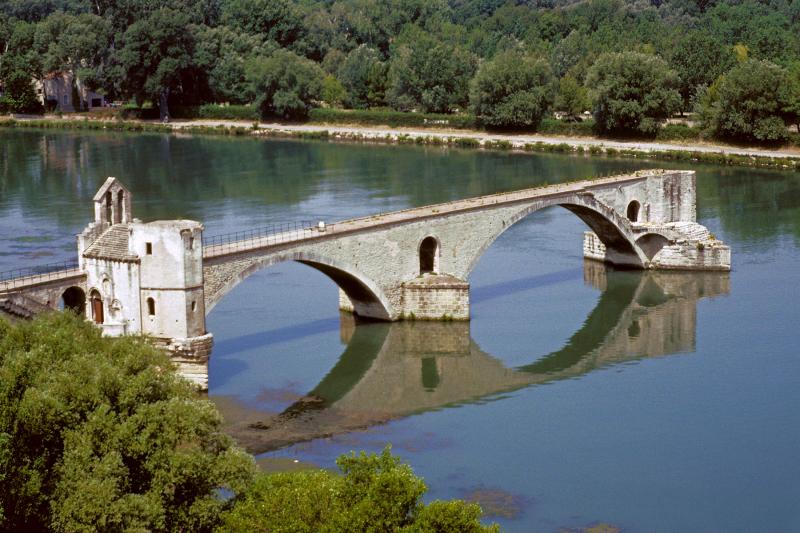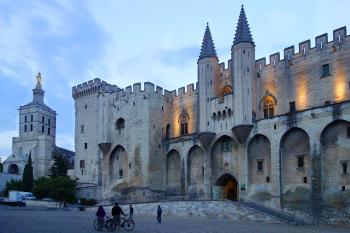Avignon: A medieval town with a youthful attitude
Appears in the Online Edition, March 2020.
Clinging to a bend in the Rhone River in the south of France, Avignon looks and feels like it stepped out of a medieval fairy tale. While it's largely famous for its 14th-century heyday as a papal capital and its even older 12th-century bridge, Avignon has plenty to offer beyond history. Today this walled Provençal town is a youthful place full of atmospheric cafes, fun shops, and numerous hide-and-seek squares ideal for postcard-writing and people-watching.
An easy side trip from nearby must-sees like Arles and Les Baux, Avignon's charms can be sampled in half a day. Climb to its hilltop park for the town's best view, tour the immense palace that was once home to popes, stroll the traffic-free shopping district, lose yourself in the back streets, or just find a shady square to call home.
The city's history dates back to well before when the Romans came to town, but it was the Roman Catholic Church that put Avignon on the map. In 1309, a French pope was elected (Pope Clement V). The new pope, fearing Italy was too dangerous, moved the papacy to Avignon, where he could enjoy a secure rule under a supportive French king. Along with clearing out vast spaces for public squares and building a three-acre papal palace, the Church erected more than three miles of protective wall (and 39 towers), mansions for cardinals, and residences for its bureaucracy. Avignon was Europe's largest construction zone, and its population grew from 6,000 to 25,000. (Today 13,000 people live within the walls.)
The massive Palace of the Popes was the most fortified palace of the time -- and with 10-foot-thick walls, it was a symbol of power. Today it's the largest surviving Gothic palace in Europe. In all, seven popes ruled from here, making Avignon the center of Christianity for nearly 100 years. The palace itself is pretty empty today. Along with lots of big, barren rooms, visitors can see a few original wall paintings, an elegant Gothic chapel, and some beautiful floor tiles. Its climbable tower offers grand views.
Nearby, the Petit Palais Museum, located in what was a cardinal's palace, displays the Church's collection of medieval Italian painting and sculpture. Visiting this museum before going to the Palace of the Popes helps furnish and populate that otherwise empty building and captures art and life during the Avignon papacy. You'll also see bits of statues and tombs -- remnants of exquisite Church art destroyed during the French Revolution.
Next, hike above the Palace of the Popes to the Jardin du Rochers des Doms for a panoramic view of Avignon, the Rhone River Valley, and the St. Benezet Bridge, made famous by the nursery rhyme "Sur le Pont d'Avignon" -- known to all French school kids. As one of only three bridges crossing the mighty Rhone in the Middle Ages, this strategically important span carried pilgrims, merchants, and armies into and out of town.
Over the years, floods damaged the bridge several times (and each time it was rebuilt). But in 1668, a particularly disastrous flood destroyed most of the bridge. This time, the townsfolk decided not to rebuild, and for more than a century, Avignon had no bridge across the Rhone. Today, you can pay 5 to walk along a section of the ramparts and onto what remains of the bridge. It's fun to be in the breezy middle of the river with a sweeping city view.
For a close-up look at Avignon life, meander the town's back streets -- home to pastry shops, earthy cafes and galleries, and cobbled lanes lined with trees and streams. I love parsing the street signs here, revealing vivid names like "Street of the Animal Furriers," "Hosiery Street," and "Street of the Golden Scissors," all of which recall the neighborhood's medieval roots.
Along the way, step inside the modern market hall, Les Halles, for a sensory celebration of organic breads, olives, and festival-of-mold cheeses. Six mornings a week, the hall is bursting with fresh produce, meats, and fish. With plenty of cheap cafes, bars, and tempting cheese shops, this is the local hotspot for lunch -- and I can't resist a big plate of mixed seafood with a glass of white wine.
Theater buffs may want to visit in July when Avignon booms with its massive three-week theater festival, featuring about 2,000 performances (hotels book up far in advance). Every venue is in action, creating a Mardi Gras-like atmosphere: The entire city is a stage, with mimes, fire-breathers, singers, and musicians filling the streets.
While there's so much to see in fascinating Provençe, a detour to Avignon is time well spent. Clean, lively, and popular with travelers, this city is an intriguing blend of medieval history, youthful energy, and urban sophistication.
IF YOU VISIT...
SLEEPING: Hotel la Mirande pampers its guests with traditional luxury in a quiet, central location behind the Palace of the Popes (splurge, www.la-mirande.fr). Autour du Petit Paradis Apartments and Aux Augustins offer 22 contemporary, well-furnished rooms and studios with kitchenettes spread over two locations (moderate, www.autourdupetitparadis.com).
EATING: Restaurant Numero 75 serves delightful salads, fish, and French cuisine in a romantic, chandeliered setting (splurge, 75 Rue Guillaume Puy, www.numero-75.com). L'Amista is a cozy, youthful, and welcoming place with a fun Provençal/Spanish-inspired menu that includes vegetarian options and tapas-style plates (moderate, 23 Rue Bonneterie, tel. 011 33 6 19 24 15 47).
GETTING AROUND: Avignon is essentially traffic-free and perfectly walkable in the old center. Shuttle vans loop through the old city and a free shuttle boat crosses the Rhone River from near the St. Benezet Bridge to a peaceful island, Ile de la Barthelasse.
TOURIST INFORMATION: www.avignon-tourisme.com.
(Rick Steves (www.ricksteves.com) writes European travel guidebooks and hosts travel shows on public television and public radio. Email him at rick@ricksteves.com and follow his blog on Facebook.)


